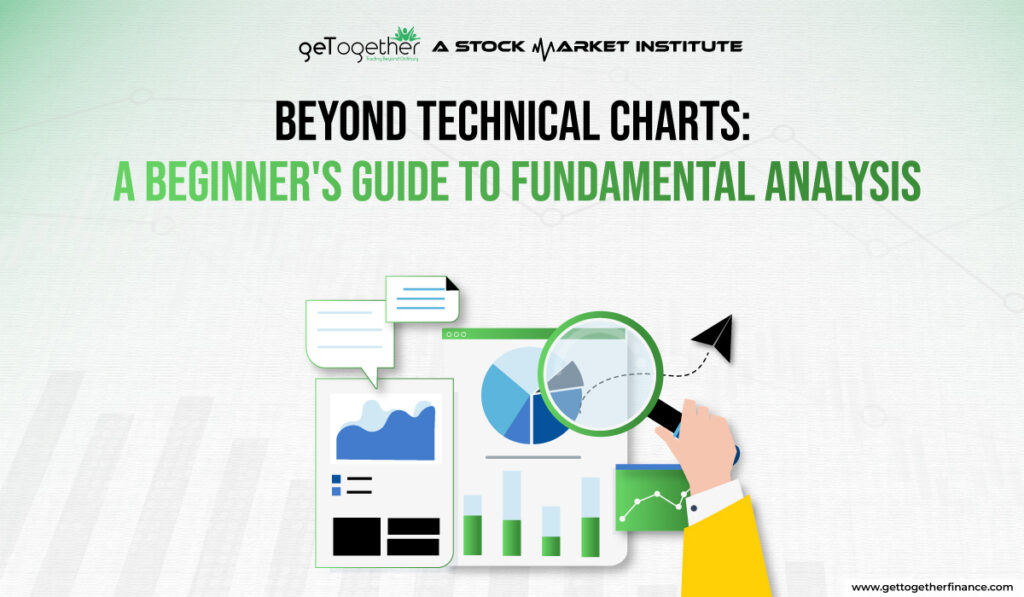Beyond Technical Charts: A Beginner’s Guide to Fundamental Analysis


Overview
Have you ever found yourself wondering how experts sort and pick the best stocks?
Well, there are mainly two common ways to study the market – fundamental and technical analysis. Fundamental analysis looks at the health record of a company to know its future direction. Where technical analysis, bypassing the fundamentals, look at the statistical patterns to decode potential price moves.
This blog is not going to talk about the tales of picking a stock, but organized a panel discussion of words on fundamental analysis. It contains comprehensive details on fundamental analysis that you need to know, including what it is, how it works, and what are its types.
For the technical analysis, take a look into the simplified insights on technical analysis.
Let’s begin without wasting a jiffy.
What is Fundamental Analysis?

Fundamental analysis is like investigating a company to understand if it’s worth investing in its stock. It studies the intrinsic value of a security via assessing its financial and economical aspects. In simpler terms, it focuses on the internal performance of the company, in terms of numbers, performance, and visions.
Fundamental analysis studies all the elements that affect a company’s performance in the market, including macroeconomics and microeconomics. That means all the figures will be measured along with the company’s market performance, reputations, earnings, financial statements, and effectiveness of management to find out the real, fair price of a stock.
The whole agenda of fundamental analysis is to find out if the stock is undervalued or overvalued among investors. Premierly, investors or traders preferred fundamental analysis to understand the fair price and forecasting the upcoming upmove/downmove in a security.
How Fundamental Analysis Works?

Have you ever noticed a detective digging data or information to find the reality behind the suspense?
Well! Fundamental analysis works the same way. It’s like detective work for investors where they dig out the information to figure out if a stock is a good buy, and how long shall they hold it to get the best out of it.
For instance, imagine you are thinking of investing in a company. Definitely, you would want to know if the company itself is making money, has any debts, is in demand, performing well financially or professionally. This is where the fundamental analysis comes in the picture.
The whole process of fundamental analysis helps you address all your concerns regarding the company’s revenues, profits, assets, and growth potential.
In technical terms, fundamentals include the macro and micro factors of a company to analyse its market positions.
Basically there are three major elements to study
- State’s economical condition
- Strength of specific industry
- Financial performance of the company
The source of fundamental facts is publicly available financial data. It includes financial statements such as 10-Q (quarterly) or 10-K (annual), 8K (reportable event) reports, company’s revenues, future growth, earnings, profit margins, return on equity and more.
The whole agenda is to figure out the intrinsic value of a stock. Contrary to an option’s intrinsic value, investors study the fundamentals of a company (the report card) and estimate the real value to know whether to hold a stock for a “long run”. By studying the intrinsic (real) value of a stock to find an opportunity to buy a stock at discount and sell at a good value (premium).
Also Read: Where Should You Do Investment
Components of Fundamental Analysis

To assess the fundamentals, investors majorly considers studying three major components:
Economical Factors
Just like weather affects the plan of business, the economy has impacts on the company’s performance too. In this, investors look at the important elements, such as GDP growth, inflation, and interest rates to view a bigger picture.
Industry Analysis
Sector or industry analysis acts like the big player of the whole picture. Using the study of overall industry, analysts take a look at the market trends, competition, and performance of specific industries.
Company Evaluation
Now let’s zoom in to the company. As mentioned before, investors/analysts dive deeper into the company’s data, including economical, financial, and market performance. For this, study of financial statements, management, and competitive position to decode its historical and potential future performance.
In the end, the study of all three factors is combined to make informed decisions about buying, holding, or selling a share. It’s like putting the pieces of a puzzle together to see the whole picture.
Types of Fundamental Analysis

Yes! Fundamental analysis comes in two flavors – quantitative and qualitative.
Let’s take a look at what these two stand for and how it helps investors make smart decisions.
Quantitative Analysis
As the name speaks for itself, quantitative analysis tells the story of numbers. It looks at essential financial statements and ratios to check on the company’s health. The fundamentals of health reports include income statement, balance sheets, cash flow, price-to-earnings (P/E), return on equity (ROE), and debt-to-equity (D/E), etc.
Qualitative Analysis
Qualitative analysis reads the story behind all the numbers. Akin to quantitative, it looks beyond the number, reading the true value of a company within the market. In this, investors/analysts read the background and work ethic to forecast the future performance. It uses quantitative factors, but mainly focuses on understanding competitive advantage, brand loyalty, skills, and value of the company.
Through this, investors figure out the complete picture – from the beginning to the potential growth and make informed decisions.
Top-down vs. Bottom-up Fundamental Analysis

Till now we have read what fundamental analysis is, how it works, and what are the basic types that can be studied to know in-depth insights about a company or its stock’s value. But what is the approach to studying to avoid getting stuck under a pile of unorganized data?
Well, there are majorly two approaches followed by most investors, depending on the preference, convenience, and practicality. Let’s take a look:
Top-Down Approach
Most preferred among investors – the top down approach. It’s like looking at the bigger picture first and narrowing it down till the final results. In this, investors check the health of the overall economy firstly, assessing GDP levels, inflation, interest rates, etc. to know the direction of the economical state of the country.
In the next phase, investors review specific prospects of the sector or concerned industry to know the preference of potential customers. At last, the study of the company’s financial and brand health is assessed.
The combined picture gives a clear view on how every aspect is ending and which direction the company’s future heading.
Bottom-Up Approach
Opposite to top-down approach, the bottom-up approach looks at the individual stock’s health first and wider the perspective. It’s like focusing on one player’s performance and checking its impact on the overall industry.
Investors who use these techniques believe that entire industries may not affect the performance of the company as much as it is assumed. It initially focuses on micro-economic factors such as earnings, statements, and finances of the company. Later it goes to industry/sector analysis to macro (economical) study.
Which Approach is Better?
Both of the approaches come with benefits and their own setbacks. It depends on the preference of an investors/analyst and their investment goals.
Some may prefer the top-down approaches for in-depth insights, while others might gel-up well with bottom-down approaches to keep the focus on the company.
By deeply understanding these two approaches, company investors can tailor their fundamental analysis and suit their needs for more informed decisions.
Fundamental Analysis (FA) vs. Technical Analysis (TA)

Before we wrap, let’s take a look at the key difference between technical analysis and fundamental analysis:
| Aspect | Fundamental Analysis (FA) | Technical Analysis (TA) |
| Focus | Company’s financial health and intrinsic value | Price and volume data, market trends, and chart patterns |
| Data Used | Financial statements, economic indicators, management | Price and volume data, charts, and technical indicators |
| Investment Horizon | Long-term | Short to long-term |
| Key Metrics | P/E ratio, EPS, revenue, profit margins | Demand and supply zone, support/resistance levels, momentum indicators |
| Assumptions | Market price eventually reflects true value | Price trends tend to persist |
| Usefulness | Identifying undervalued stocks, long-term investing | Timing buy/sell decisions, short-term trading strategies |
Last Words
In the end, what matters is the precision of study and how reliable the techniques are, right? Well, fundamental analysis is the conventional approach to look at the market, company, or specific industry. But the credibility of fundamental analysis has also questioned many as the data can easily be manipulated.
That’s how the technical analysis came into the picture. As the technical analyst says, the data can lie but charts can’t. Hence, to foolproof your research, ensure to dive deeper into both – ocean of fundamental and technical information. Better go hard than go home.
FAQs
What is fundamental analysis and its objectives?
Fundamental analysis is a technique through which you can assess a security, various factors affecting it, and its intrinsic (real) value.
Are there any types of fundamental analysis?
Yes! There are mainly two types of fundamental analysis i.e. qualitative and quantitative. Quantitative analysis dive deeper into numbers to know the stock value whereas qualitative (more complex than its sounds) checks out the strength and brand value of the company.
Why is fundamental analysis important?
Fundamental analysis helps in assessing the true value of a security and identify whether a stock is undervalued or overvalued. It also helps analyze financial health and management quality, allowing investors to make smart decisions.
What are the tools for fundamental analysis?
Financial statements: Income statement, balance sheet, cash flow statement.
Ratio analysis: P/E ratio, ROE, debt-to-equity ratio.
Economic indicators: GDP growth, inflation rate, interest rates.
Industry analysis: Growth potential, competitive dynamics, regulatory environment.
Management assessment: Quality and competence of the management team.
What is the difference between qualitative and quantitative fundamental analysis?
Although both of them use different factors to assess fundamentals of a company, quantitative analysis is easily read and digs deep into financial reports, earnings, expenses, and valuation of the company. On the flip side, qualitative analysis gets into the brand value and company’s strength about the value and strength in the market, for which sometimes it uses factors of quantitative analysis too.
What is the difference between technical analysis and fundamental analysis?
Let’s talk about where the difference lies! Fundamental analysis looks at the company’s economic and financial situations to scale whether it’s overvalued or undervalued. On the flip side, technical analysis looks at the charts and patterns to understand stock price actions and predict future movements. In brief- one looks at your bank and the other looks at your style, easy peasy, right!
Why do investors read financial statements when doing fundamental analysis?
Financial statement is like a report card – you get to know how much you performed and how far is your future by looking at the number. Akin to this, a financial statement includes several key metrics that helps investors know whether the stock is overvalued or undervalued. They look deep into profitability, assets, liabilities, sales, and profits over time to decode the actual worth of the company. Pretty long process, but get your outcome based on facts and statistics, right!



 Facebook
Facebook  Instagram
Instagram  Youtube
Youtube 
